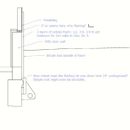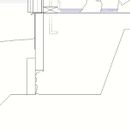When is flashing not needed with exterior rigid foam?
I was dealing with the tedious process of finding a guy with a brake to make my flashing at the transition from the exterior foundation insul to the exterior wall insul and thought, “Why!?”
The sheathing is exactly 1/2″ proud of the cinder block foundation wall. I’ve excavated to allow for adding rigid foam 36″ below grade. There is the jagged 2″ proud footing overpour ledge to deal, say 24″ below grade, so there is going to be a ledge in the insul at some point unless I just stop there or go all the way to the eave with 3 1/2 or 4″ (4 or 5 layers of foam). My question is where and how to flash?
I propose putting 1/2″ board over the cinderblock to build it out to the sheathing level and then 2 more layers of foam over that and no horizontal seam anywhere near the bottom plate of the 2×4 wall. What’s wrong with that?
After that, as I go below the block at that 24″ below grade 2″ jagged edge, I create a ledge in the foam layers down there, but maybe that is protected by a bend in the dimple mat. I’d almost go all the way up to the roof with the extra 2″ of insul but I’m being cheap and lazy (sorry folks) and doing 1.5″ of foam so I can nail vinyl (sorry again) without furring.
I guess my main question is what continuous foam does to the practice of flashing where the seam is buried, not like at the top of a window where of course there is no covering up the issue and it must be flashed.
Question 2: Another part of my foundation is shallow at 14″ below grade and 6″ of that is a jagged footer. It needs insul to frost protect and meet the new energy code. Any ideas on that would be appreciated. Sort of the same issue, but my pictures shows I never considered just going all the way past the sheathing with the foundation foam.
Thanks.
GBA Detail Library
A collection of one thousand construction details organized by climate and house part











Replies
Even with dimple mat between the foam and dirt I'd be reluctant to use polyiso on the exterior side of a CMU wall. Transition to EPS where it goes below grade- one flooding event that filled up between the dimple mat and foam for more than an few hours could ruin the polyiso, but EPS would dry at a reasonable rate once the tide goes out.
Flashing is part of the defined drain-plane which has to be continuous, directing the bulk water to the exterior. So if it were continuous EPS, with the weather resistant barrier (WRB) on the exterior side of the foam, window flashing would have to be directed to the WRB side and lapped correctly. This is typical of an "outie" mount window.
With an "innie" mounted window the flashing & WRB is placed between the sheathing and foam, but at the transition to the foundation foam it needs flashing to direct bulk water coming down the WRB out to the dimple-mat side if the foundation rather than letting it saturate the stemwall CMU, and potentially the foundation sill.
For a shallow flashing on foam seams it's fine to use EPDM flashing tape to implement the Z-flashing rather than brake bent metal flashing. For 2" foam it's do-able with 6" wide flashing tape, but it gets to be pretty awkward if the foam is much thicker than that.
The IRC 2015 and later prescribes 2x4/R13 + R10 continuous insulation minimum for above grade walls in zone 5, so 2" of polyiso would get you there. For basements & crawlspace foundations it calls out R15 continuous insulation. With 2.5" Type-II EPS on the foundation it would deliver R10.5, and would be co-planar with your framed wall sheathing foam, but it would also need an additional R4.5+ on the interior side (such as 3/4" fire rated polyiso glued to the CMU in the crawl space / basement, or 1.5" of rigid rock wool.) With 2" or more of polyiso on the exterior of the band joist & foundation sill, the rim joist can be insulated with unfaced R15 rock wool, or 2" of HFO blown closed cell foam that laps down over to become continuous with the interior side stemwall insulation.
The shallow end of the foundation needs the full frost protected foundation treatment, which usually involves buried "wing" foam extending out from the footing for some distance that's related to the 100 year frost depth for your area. (I'm not your best resource on those particulars.)
Shawn,
Depending on where you are, it may be a code requirement. Our code here in BC says there has to be flashing whenever the substrate changes.
Thanks so much Dana and Malcolm. My 2015 MI code says walls: 13/5 and slab: 10, 2ft. aha, but There is no section in table N1102.1.1 for a shallow foundation. It's good you got me checking again. My plan reviewer seemed to be going for 24" on my shallow foundation, which would put me in horizontal to the outside, and now I see the text in the code about that. I'll go for the EPS where there is a risk of soaking.
To be clear, MI code calls out R15 c.i. for crawlspace walls, so even with R10 EPS on the exterior of the CMU it would still need another R5 c.i. on the interior. See the right-most column:
https://up.codes/viewer/michigan/mi-residential-code-2015/chapter/11/re-energy-efficiency#N1102.1.1
Thanks. My whole building is a slab. There is 30" of cmu above the slab level of the with existing drywall and 1" of foam. I'll add 3 or 4 " to the outside at that point I think. For the wood walls, I'm doing cavity mineral wool R15 plus 1.5" poliso.